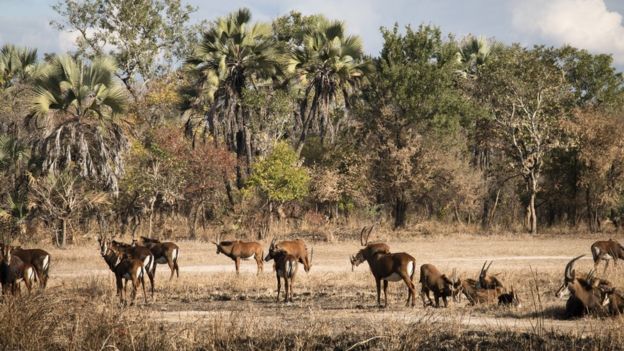 Gorongosa's
predicament was in many ways indicative of the state of Mozambique's tourist
industry, which had once been a significant part of the country's economy.Despite
more than 2,700 kilometres of coral-fringed coastline, abundant natural beauty,
rich cultural heritage, and its proximity to South Africa, one of the world's
top tourist destinations, Mozambique was making far less money from
international visitors than neighbours such as Zimbabwe and Zambia.Years
of armed conflict scared off holidaymakers, and vital infrastructure such as
cross-country roads and train lines had been all-but destroyed.Labyrinthine
visa processes and the relative paucity of tour operators certainly didn't help
matters, but most importantly, investment in tourism was desperately low.Today,
Vasco is the communications director of a newly restored Gorongosa, which is
once again making a name for itself as a premier safari destination, while acting
as a model for many of Mozambique's long-neglected attractions.The restoration
project, which began in 1994 with the help of the African Development Bank, is
spearheaded by 56-year-old Greg Carr, an ebullient tech
entrepreneur-turned-philanthropist from Idaho Falls in the US who made his
fortune at an early age, and was looking for a venture to which, as he puts it,
he could devote the rest of his life.Mr Carr visited Mozambique in 2004, at the
invitation of the country's ambassador to New York, at a time when the country
was "the single poorest nation on earth," he says. Read here.
Gorongosa's
predicament was in many ways indicative of the state of Mozambique's tourist
industry, which had once been a significant part of the country's economy.Despite
more than 2,700 kilometres of coral-fringed coastline, abundant natural beauty,
rich cultural heritage, and its proximity to South Africa, one of the world's
top tourist destinations, Mozambique was making far less money from
international visitors than neighbours such as Zimbabwe and Zambia.Years
of armed conflict scared off holidaymakers, and vital infrastructure such as
cross-country roads and train lines had been all-but destroyed.Labyrinthine
visa processes and the relative paucity of tour operators certainly didn't help
matters, but most importantly, investment in tourism was desperately low.Today,
Vasco is the communications director of a newly restored Gorongosa, which is
once again making a name for itself as a premier safari destination, while acting
as a model for many of Mozambique's long-neglected attractions.The restoration
project, which began in 1994 with the help of the African Development Bank, is
spearheaded by 56-year-old Greg Carr, an ebullient tech
entrepreneur-turned-philanthropist from Idaho Falls in the US who made his
fortune at an early age, and was looking for a venture to which, as he puts it,
he could devote the rest of his life.Mr Carr visited Mozambique in 2004, at the
invitation of the country's ambassador to New York, at a time when the country
was "the single poorest nation on earth," he says. Read here.Thursday, May 5, 2016
The rebirth of Mozambique's natural treasure
 Gorongosa's
predicament was in many ways indicative of the state of Mozambique's tourist
industry, which had once been a significant part of the country's economy.Despite
more than 2,700 kilometres of coral-fringed coastline, abundant natural beauty,
rich cultural heritage, and its proximity to South Africa, one of the world's
top tourist destinations, Mozambique was making far less money from
international visitors than neighbours such as Zimbabwe and Zambia.Years
of armed conflict scared off holidaymakers, and vital infrastructure such as
cross-country roads and train lines had been all-but destroyed.Labyrinthine
visa processes and the relative paucity of tour operators certainly didn't help
matters, but most importantly, investment in tourism was desperately low.Today,
Vasco is the communications director of a newly restored Gorongosa, which is
once again making a name for itself as a premier safari destination, while acting
as a model for many of Mozambique's long-neglected attractions.The restoration
project, which began in 1994 with the help of the African Development Bank, is
spearheaded by 56-year-old Greg Carr, an ebullient tech
entrepreneur-turned-philanthropist from Idaho Falls in the US who made his
fortune at an early age, and was looking for a venture to which, as he puts it,
he could devote the rest of his life.Mr Carr visited Mozambique in 2004, at the
invitation of the country's ambassador to New York, at a time when the country
was "the single poorest nation on earth," he says. Read here.
Gorongosa's
predicament was in many ways indicative of the state of Mozambique's tourist
industry, which had once been a significant part of the country's economy.Despite
more than 2,700 kilometres of coral-fringed coastline, abundant natural beauty,
rich cultural heritage, and its proximity to South Africa, one of the world's
top tourist destinations, Mozambique was making far less money from
international visitors than neighbours such as Zimbabwe and Zambia.Years
of armed conflict scared off holidaymakers, and vital infrastructure such as
cross-country roads and train lines had been all-but destroyed.Labyrinthine
visa processes and the relative paucity of tour operators certainly didn't help
matters, but most importantly, investment in tourism was desperately low.Today,
Vasco is the communications director of a newly restored Gorongosa, which is
once again making a name for itself as a premier safari destination, while acting
as a model for many of Mozambique's long-neglected attractions.The restoration
project, which began in 1994 with the help of the African Development Bank, is
spearheaded by 56-year-old Greg Carr, an ebullient tech
entrepreneur-turned-philanthropist from Idaho Falls in the US who made his
fortune at an early age, and was looking for a venture to which, as he puts it,
he could devote the rest of his life.Mr Carr visited Mozambique in 2004, at the
invitation of the country's ambassador to New York, at a time when the country
was "the single poorest nation on earth," he says. Read here.
Subscribe to:
Post Comments (Atom)
0 comentários:
Post a Comment